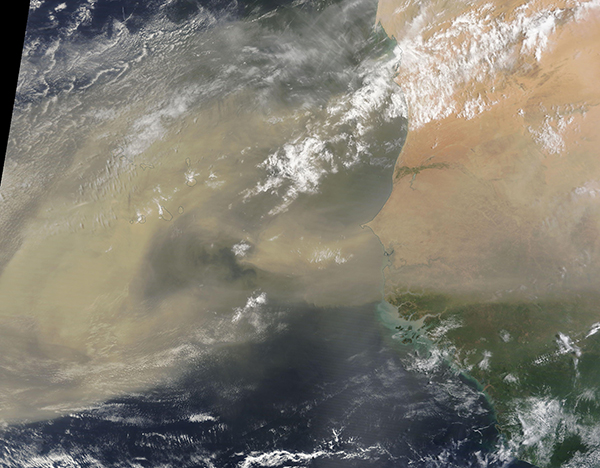Images
June 4, 2022 - Dust off of West Africa
Tweet
Northern Africa’s Sahara Desert has been renown as the Earth’s largest source of airborne dust. Each year, winds lift about 800 million metric tons of desert dust from the region. Dust storms are common during the spring, summer, and early fall, when huge plumes of dry, dusty air from the Sahara Desert (the Saharan Air Layer) blow westward over the tropical Atlantic Ocean.
On June 3, 2022, the Moderate Resolution Imaging Spectroradiometer (MODIS) on board NASA’s Terra satellite captured a true-color image of a massive river of dust on the move from the Sahara Desert across the Atlantic Ocean.
This image captures just a portion of a near-continuous mass of airborne dust that rises in Algeria and stretches almost 2,500 miles (4,000 km) across the ocean. The dust is so thick that the Cape Verde Islands, which lie between 368 and 530 miles (600-850 km) off the African coast, are completely obscured from view.
Dust from Africa can affect air quality as far away as North and South America if it rides the Saharan Air Layer across the Atlantic. The dust also plays an important ecological role, such as fertilizing soils in the Amazon and building beaches in the Caribbean. The dry, warm, and windy conditions associated with Saharan Air Layer outbreaks can also suppress the formation and intensification of tropical cyclones.
Image Facts
Satellite:
Terra
Date Acquired: 6/3/2022
Resolutions:
250m ( B)
Bands Used: 1,4,3
Image Credit:
MODIS Land Rapid Response Team, NASA GSFC
Tweet
Northern Africa’s Sahara Desert has been renown as the Earth’s largest source of airborne dust. Each year, winds lift about 800 million metric tons of desert dust from the region. Dust storms are common during the spring, summer, and early fall, when huge plumes of dry, dusty air from the Sahara Desert (the Saharan Air Layer) blow westward over the tropical Atlantic Ocean.
On June 3, 2022, the Moderate Resolution Imaging Spectroradiometer (MODIS) on board NASA’s Terra satellite captured a true-color image of a massive river of dust on the move from the Sahara Desert across the Atlantic Ocean. This image captures just a portion of a near-continuous mass of airborne dust that rises in Algeria and stretches almost 2,500 miles (4,000 km) across the ocean. The dust is so thick that the Cape Verde Islands, which lie between 368 and 530 miles (600-850 km) off the African coast, are completely obscured from view.
Dust from Africa can affect air quality as far away as North and South America if it rides the Saharan Air Layer across the Atlantic. The dust also plays an important ecological role, such as fertilizing soils in the Amazon and building beaches in the Caribbean. The dry, warm, and windy conditions associated with Saharan Air Layer outbreaks can also suppress the formation and intensification of tropical cyclones.
Image Facts
Satellite:
Terra
Date Acquired: 6/3/2022
Resolutions:
250m ( B)
Bands Used: 1,4,3
Image Credit:
MODIS Land Rapid Response Team, NASA GSFC




